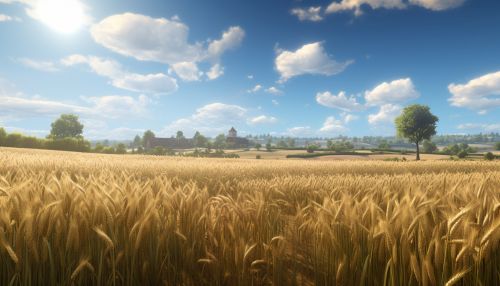Crop yield
Introduction
Crop yield refers to the measurement of the amount of agricultural production harvested per unit of land area. Crop yield is a critical concept in agricultural and farming practices as it directly relates to the productivity and sustainability of the land. It is measured in quantities such as bushels per acre, tons per hectare, or kilograms per square meter.


Factors Affecting Crop Yield
Numerous factors can influence crop yield, including but not limited to the genetic potential of the crop, the soil's quality, the availability of water, the use of fertilizers and pesticides, and the management practices employed by the farmer.
Genetic Potential
The genetic potential of a crop is the inherent capacity of a plant species to produce under optimal conditions. This potential is influenced by the plant's genetic makeup, which is determined by its breeding and selection. Modern agricultural practices often involve the use of genetically modified organisms (GMOs) to enhance crop yield.
Soil Quality
Soil quality is another significant factor that influences crop yield. The soil's physical and chemical properties, including its texture, structure, pH level, and nutrient content, can significantly affect the growth and productivity of crops.
Water Availability
Water is essential for plant growth and development. The availability of water, either through rainfall or irrigation, can significantly influence crop yield. Both water scarcity and waterlogging can lead to reduced crop yield.
Fertilizers and Pesticides
The use of fertilizers and pesticides can significantly enhance crop yield. Fertilizers provide essential nutrients to the soil, promoting plant growth and development, while pesticides protect crops from pests and diseases that can reduce yield.
Farm Management Practices
Farm management practices, such as crop rotation, intercropping, and the use of cover crops, can significantly impact crop yield. These practices can enhance soil fertility, control pests and diseases, and improve water use efficiency.
Crop Yield Estimation and Prediction
Crop yield estimation and prediction are essential components of agricultural planning and policy-making. Accurate yield estimates can help farmers make informed decisions about crop management and marketing, while policymakers can use these estimates to plan for food security and agricultural development.
Traditional Methods
Traditional methods of crop yield estimation involve field sampling and visual observation. These methods, while straightforward, can be labor-intensive and may not always provide accurate estimates due to the variability within and between fields.
Modern Techniques
Modern techniques for crop yield estimation and prediction involve the use of remote sensing technology and crop simulation models. Remote sensing technology, such as satellite imagery and drone-based sensors, can provide detailed and timely information about crop conditions and growth stages. Crop simulation models, on the other hand, use mathematical equations to represent the interactions between the crop, the environment, and management practices.
Improving Crop Yield
Improving crop yield is a critical goal in agriculture. It can be achieved through various strategies, including the use of improved crop varieties, enhanced soil management practices, efficient water use, and the application of modern technologies.
Improved Crop Varieties
The development and use of improved crop varieties, often through plant breeding and genetic engineering, is a common strategy for improving crop yield. These improved varieties can have higher yield potential, improved resistance to pests and diseases, and enhanced tolerance to environmental stresses.
Enhanced Soil Management
Enhanced soil management practices, such as the use of organic amendments, cover crops, and conservation tillage, can improve soil health and fertility, leading to increased crop yield.
Efficient Water Use
Efficient water use, through practices such as drip irrigation and deficit irrigation, can improve water use efficiency and enhance crop yield, especially in water-scarce regions.
Application of Modern Technologies
The application of modern technologies, such as precision agriculture and digital farming, can significantly improve crop yield. These technologies allow for the precise application of inputs, such as fertilizers and pesticides, and the real-time monitoring of crop conditions, leading to improved crop management and increased yield.
Conclusion
Crop yield is a critical concept in agriculture, as it directly relates to the productivity and sustainability of the land. Numerous factors can influence crop yield, including the genetic potential of the crop, the quality of the soil, the availability of water, the use of fertilizers and pesticides, and the management practices employed by the farmer. Accurate estimation and prediction of crop yield are essential for agricultural planning and policy-making. Improving crop yield, through strategies such as the use of improved crop varieties, enhanced soil management, efficient water use, and the application of modern technologies, is a critical goal in agriculture.
